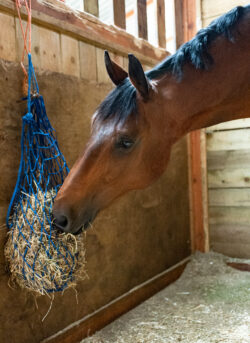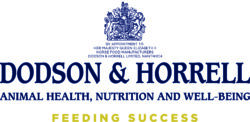With it being mid-winter, our horses are eating their way through a fair bit of hay at the moment. This led to an interesting discussion in the SEIB
horse insurance team about how much hay it is ideal to feed a horse. However, with no definitive answer amongst us, we turned to the equine nutrition experts over at
Dodson & Horrell for some valuable advice.
All horses need roughage in their diets as it is a major contributor to their energy and nutrient requirements each day. Roughage can come from many sources, such as hay, haylage, and/or grass. The amount you provide each day should equate to at least 1.5-2% of their bodyweight in dry matter.
 For a horse to lose weight
For a horse to lose weight
For horses to lose weight, they need to be in negative energy balance, or in other words, using more energy than they consume. To achieve this, total daily calorie intake needs to be reduced. Testing your roughage can give an indication of its digestible energy content. If you then weigh the amount of hay or haylage that you provide each day, you can calculate its energy contribution to total diet. If you are able to swap to different types of hay or haylage relatively easily, you could preferentially choose one that has a lower calorie content to help facilitate weight loss. If you aren’t able to swap the dry roughage in your horse’s diet easily, using complementary products low in calories and suitable for good doers is important. If you have been feeding hay or haylage free choice, start by weighing the amount your horse consumes each day, as this will provide a number which can then be slightly reduced (but not below 1.5% of their bodyweight in dry matter weight) to support weight loss. When reducing total intake, it’s important to try to lengthen the amount of time it takes for a horse to eat a set amount, rather than leaving them without roughage for long periods, as steady natural trickle feeding helps support a healthy digestive system. For horses who are turned out on pasture every day, utilising comfortably fitting grazing muzzles, or employing strip grazing in the field can help slow down feeding rate.
For a horse to gain weight
For horses to gain weight, their diet needs to be in a positive energy balance (i.e. eating more calories than they are burning). Similar to weight loss situations, testing forage can help assess its energy content. If it isn’t possible to swap to a higher energy hay or haylage option, adding in a complementary feed higher in calories and suitable for poor doers can help. It’s ok to feed more than 2% of bodyweight in dry matter each day to horses who need to gain weight, as long as they don’t have clinical concerns which would prevent this from being a good option (e.g. poor dentition). In fact, providing forage free choice can help provide an opportunity for more calorie consumption, whilst satisfying the same natural trickle feeding behaviours that all horses need to display, whether they need to lose or gain weight. If your horse has free access to pasture and to forage and they are still a poor doer, consider reaching out to your feed brand’s nutritional helpline to discuss your feeding routine in more depth. They will often provide free advice to support your goals. In addition, mention your horse’s condition to your vet at their next visit. Together, nutrition and veterinary advice can help put minds at ease and provide the right combination of advice to help best support any needed changes in your horse’s weight.
Huge thanks to the team at Dodson & Horrell for their expert knowledge on how much hay to feed a horse.
 About SEIB
About SEIB
SEIB have been arranging
horse insurance for over 50 years. This experience allows us to tailor policies to suit your circumstances and ensure that you and your horses are covered should the worst happen.
 For a horse to lose weight
For horses to lose weight, they need to be in negative energy balance, or in other words, using more energy than they consume. To achieve this, total daily calorie intake needs to be reduced. Testing your roughage can give an indication of its digestible energy content. If you then weigh the amount of hay or haylage that you provide each day, you can calculate its energy contribution to total diet. If you are able to swap to different types of hay or haylage relatively easily, you could preferentially choose one that has a lower calorie content to help facilitate weight loss. If you aren’t able to swap the dry roughage in your horse’s diet easily, using complementary products low in calories and suitable for good doers is important. If you have been feeding hay or haylage free choice, start by weighing the amount your horse consumes each day, as this will provide a number which can then be slightly reduced (but not below 1.5% of their bodyweight in dry matter weight) to support weight loss. When reducing total intake, it’s important to try to lengthen the amount of time it takes for a horse to eat a set amount, rather than leaving them without roughage for long periods, as steady natural trickle feeding helps support a healthy digestive system. For horses who are turned out on pasture every day, utilising comfortably fitting grazing muzzles, or employing strip grazing in the field can help slow down feeding rate.
For a horse to gain weight
For horses to gain weight, their diet needs to be in a positive energy balance (i.e. eating more calories than they are burning). Similar to weight loss situations, testing forage can help assess its energy content. If it isn’t possible to swap to a higher energy hay or haylage option, adding in a complementary feed higher in calories and suitable for poor doers can help. It’s ok to feed more than 2% of bodyweight in dry matter each day to horses who need to gain weight, as long as they don’t have clinical concerns which would prevent this from being a good option (e.g. poor dentition). In fact, providing forage free choice can help provide an opportunity for more calorie consumption, whilst satisfying the same natural trickle feeding behaviours that all horses need to display, whether they need to lose or gain weight. If your horse has free access to pasture and to forage and they are still a poor doer, consider reaching out to your feed brand’s nutritional helpline to discuss your feeding routine in more depth. They will often provide free advice to support your goals. In addition, mention your horse’s condition to your vet at their next visit. Together, nutrition and veterinary advice can help put minds at ease and provide the right combination of advice to help best support any needed changes in your horse’s weight.
Huge thanks to the team at Dodson & Horrell for their expert knowledge on how much hay to feed a horse.
For a horse to lose weight
For horses to lose weight, they need to be in negative energy balance, or in other words, using more energy than they consume. To achieve this, total daily calorie intake needs to be reduced. Testing your roughage can give an indication of its digestible energy content. If you then weigh the amount of hay or haylage that you provide each day, you can calculate its energy contribution to total diet. If you are able to swap to different types of hay or haylage relatively easily, you could preferentially choose one that has a lower calorie content to help facilitate weight loss. If you aren’t able to swap the dry roughage in your horse’s diet easily, using complementary products low in calories and suitable for good doers is important. If you have been feeding hay or haylage free choice, start by weighing the amount your horse consumes each day, as this will provide a number which can then be slightly reduced (but not below 1.5% of their bodyweight in dry matter weight) to support weight loss. When reducing total intake, it’s important to try to lengthen the amount of time it takes for a horse to eat a set amount, rather than leaving them without roughage for long periods, as steady natural trickle feeding helps support a healthy digestive system. For horses who are turned out on pasture every day, utilising comfortably fitting grazing muzzles, or employing strip grazing in the field can help slow down feeding rate.
For a horse to gain weight
For horses to gain weight, their diet needs to be in a positive energy balance (i.e. eating more calories than they are burning). Similar to weight loss situations, testing forage can help assess its energy content. If it isn’t possible to swap to a higher energy hay or haylage option, adding in a complementary feed higher in calories and suitable for poor doers can help. It’s ok to feed more than 2% of bodyweight in dry matter each day to horses who need to gain weight, as long as they don’t have clinical concerns which would prevent this from being a good option (e.g. poor dentition). In fact, providing forage free choice can help provide an opportunity for more calorie consumption, whilst satisfying the same natural trickle feeding behaviours that all horses need to display, whether they need to lose or gain weight. If your horse has free access to pasture and to forage and they are still a poor doer, consider reaching out to your feed brand’s nutritional helpline to discuss your feeding routine in more depth. They will often provide free advice to support your goals. In addition, mention your horse’s condition to your vet at their next visit. Together, nutrition and veterinary advice can help put minds at ease and provide the right combination of advice to help best support any needed changes in your horse’s weight.
Huge thanks to the team at Dodson & Horrell for their expert knowledge on how much hay to feed a horse.
 About SEIB
SEIB have been arranging horse insurance for over 50 years. This experience allows us to tailor policies to suit your circumstances and ensure that you and your horses are covered should the worst happen.
About SEIB
SEIB have been arranging horse insurance for over 50 years. This experience allows us to tailor policies to suit your circumstances and ensure that you and your horses are covered should the worst happen.



